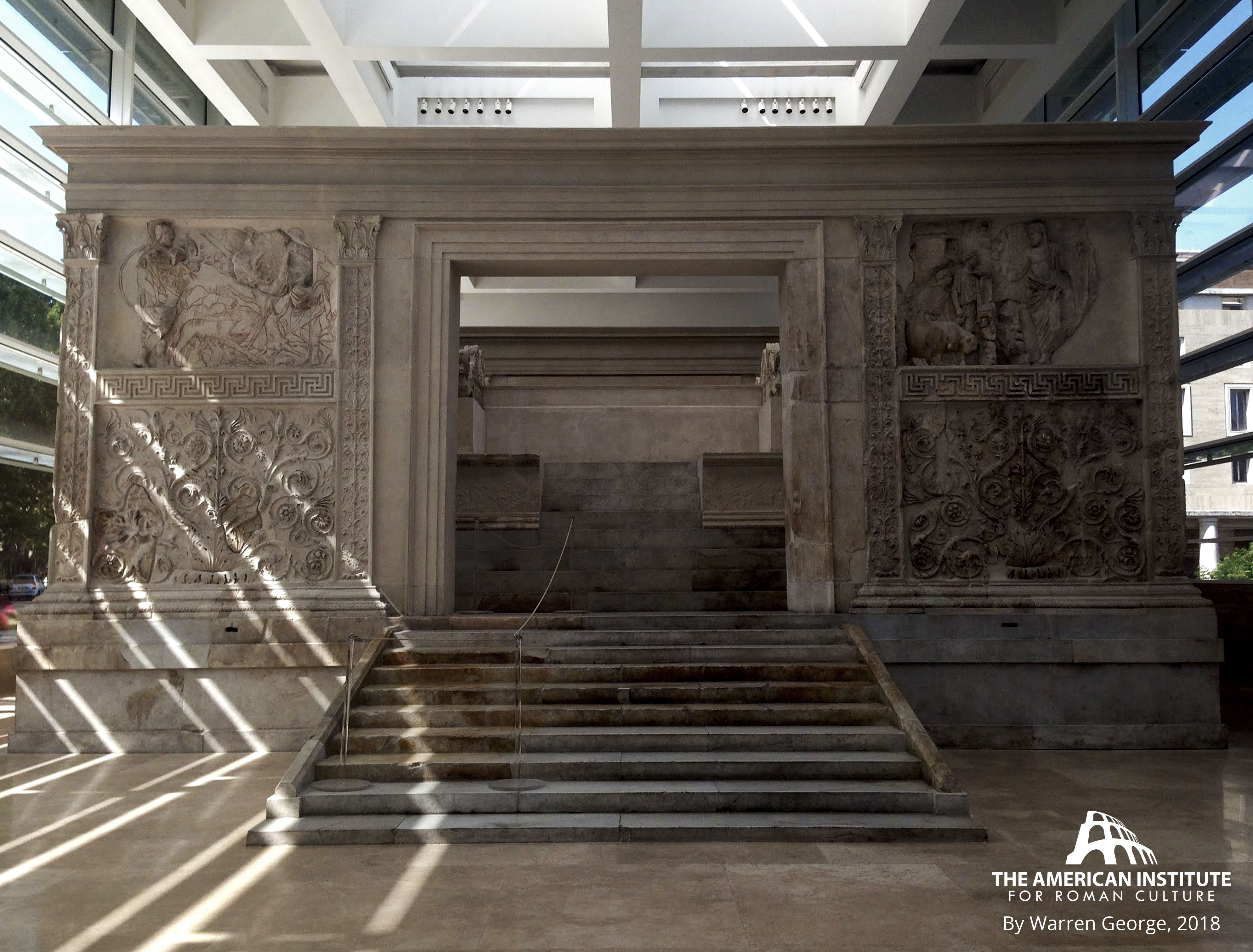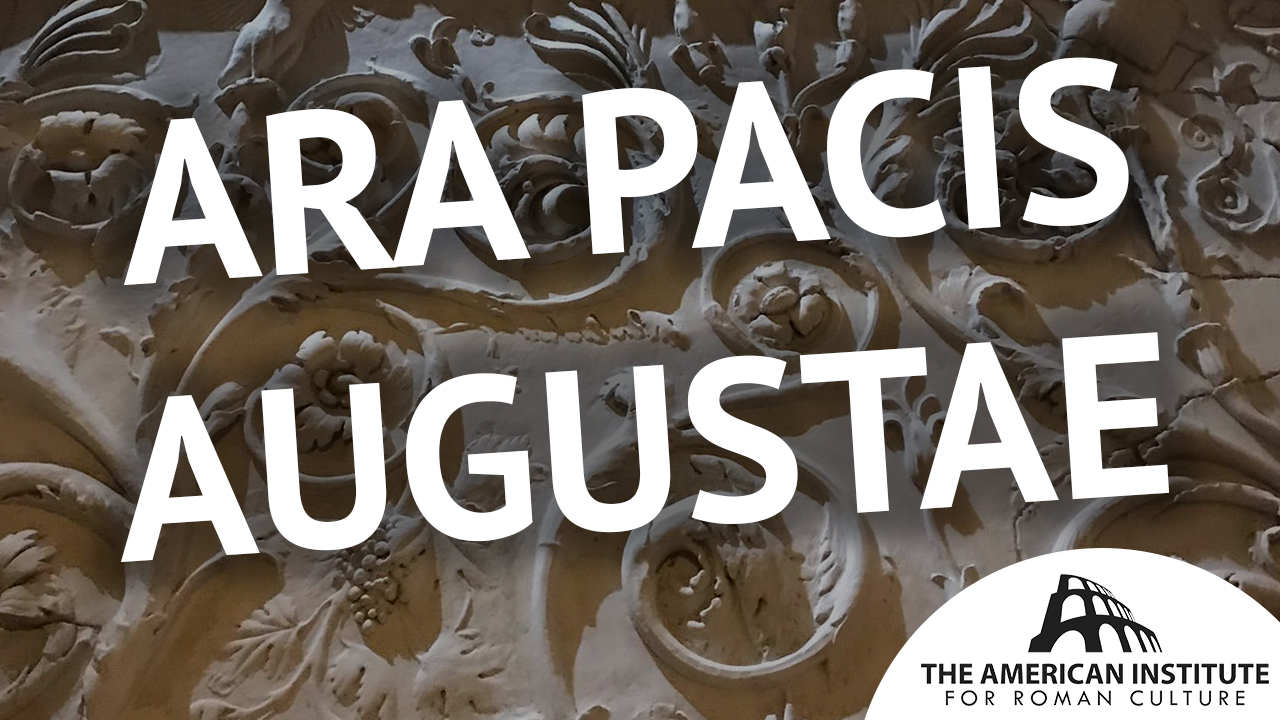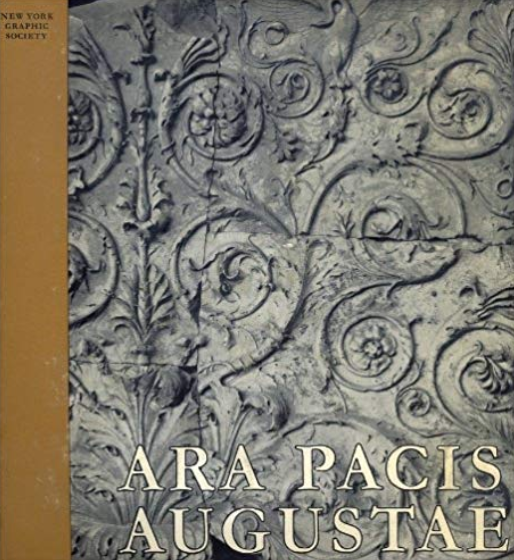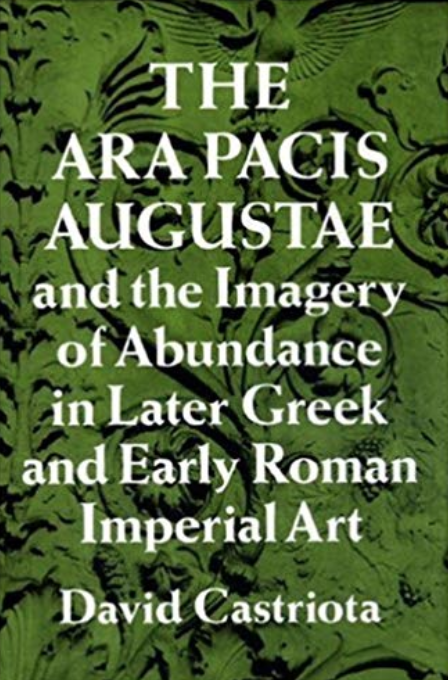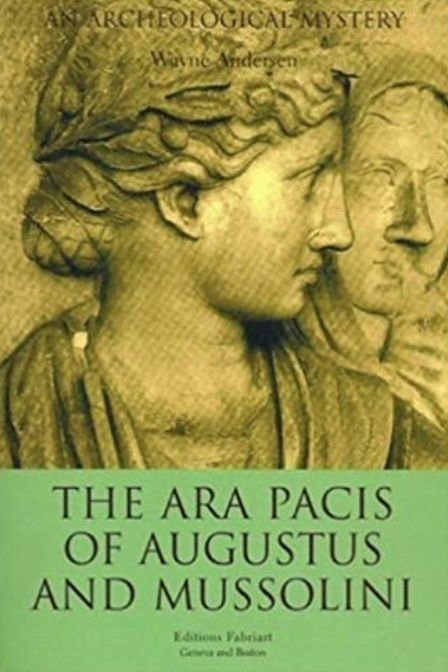Start with our video overview:
The Ara Pacis Augustae, or Altar of Augustan Peace, is an ancient Roman altar erected by the Roman Senate to celebrate Augustus’s victorious return from Spain and Gaul. It was constructed between 13 and 9 BC, during a period of political stability and cultural rebirth in Rome known as the Pax Romana. It was constructed from solid blocks of carrara marble with dimensions of 10.5 meters squared. The altar was located on the Campus Martius, and was roofless with two entrances by the wall that surrounded the altar.
The reliefs on the altar portray scenes from Augustus’s reign, including the sacrifice of a bull, which was a typical ritual during the period, and the imperial family procession. In addition to scenes from Augustus’ reign, the Ara Pacis Augustae depicts allegorical figures including young women surrounded by symbols of abundance and prosperity such as fruit and flowers, insects, birds, and lizards.
The monument was also a memorial to Augustus’s family: they are represented in the procession depicted on the altar, including his wife Livia, and his two sons, Gaius and Lucius. Augustus used this opportunity to promote his dynasty and the idea of family values in Rome. The presence of his family on the altar was also a reminder of Augustus’s succession plan and the Augustan monarchy which was a time of enormous political, social, and cultural development in Roman history. Augustus established a new style of government that merged features of the previous Roman Republic with new institutions, and he promoted a return to traditional Roman values and culture.
The altar is also remarkable for its use of color. Originally, the monument would have been painted in vivid colors to stand out against the white marble and create a dramatic contrast. The color has not been preserved due to exposure to the elements, and with the passage of time and the ongoing flooding of the Tiber River, the altar was gradually buried, though it was partially protected by a new boundary wall built during the time of Hadrian. By Late Antiquity, it had almost vanished from view. During the Renaissance, some portions of the altar were excavated undeath a palace. The altar was fully recovered through a daring excavation during Mussolini‘s rule and was then reconstructed in a new museum.
The Ara Pacis Museum, which was opened in 2006 and designed by Richard Meier, provides visitors with an immersive experience showcasing the history and rediscovery of the altar through various multimedia displays, panels, and models. Visitors can also use new VR goggles and colored lighting to visualize the original appearance of the altar without causing damage to the monument.
The Ara Pacis Augustae was an important propaganda tool for Augustus. It was intended to promote his image as a merciful emperor who brought peace and prosperity to Rome after putting an end to the civil wars, and to serve as a monument to his family and dynasty. The Ara Pacis Augustae’s enduring legacy can be seen in its influence on Western art and architecture.
Sources:
Beard, M. (2015). SPQR: A history of ancient Rome. Profile Books.
Pollini, John. (2012) From Republic to Empire: Rhetoric, Religion, and Power in the Visual Culture of Ancient Rome. Norman: University of Oklahoma Press
Cooley, Alison E. (2011) “The Ara Pacis Augustae and the Imagery of Abundance in Later Roman Antiquity.” In Rome, Ostia, Pompeii: Movement and Space, edited by Ray Laurence and David J.
Newsome, 101–16. Oxford: Oxbow Books
Kleiner, Fred S. (2010) A History of Roman Art. Belmont, CA: Wadsworth Cengage Learning
Meyer, E.A.(2009) “The Augustan Principate: Historical Context and Institutional Change.” In A Companion to Julius Caesar, edited by Miriam Griffin, 402-419. Oxford: Blackwell Publishing.
Coarelli, F. (2003). The Ara Pacis Augustae. Harvard University Press.
Galinsky, Karl. (1996) Augustan Culture: An Interpretive Introduction. Princeton, NJ: Princeton University Press
Syme, Ronald. (1939) The Roman Revolution. Oxford: Oxford University Press.
Platner, S. B., & Ashby, T. (1929). A Topographical Dictionary of Ancient Rome. Oxford: Oxford University Press.
The altar was located in the Campus Martius, with two entrances, on two different street levels, reproduced inside the museum. The East entrance faced the Via Late. The West faces the river. It was in close proximity to the Augustan meridian and Gnomon (sundial obelisk from Egypt).
With the passing of time, and continual flooding of the Tiber River, the altar was slowly buried, though protected by a new boundary wall in the Hadrianic period. It all but disappeared from view by Late Antiquity. Portions were recovered in the Renaissance but too difficult to fully extract, now under a massive palazzo. Only a daring excavation under Mussolini recovered the altar, reassembled in a new museum. The Fascist era museum, next to the liberated Mausoleum of Augustus, was in use until demolished for the current Ara Pacis museum on the same location.
Like most white marble sculptural constructions, the figures originally were vividly painted, but the color has not been preserved. Today, through rigorous study and analysis of analogous material in Rome and sculpture throughout the empire, it is possible to discern its original appearance through the use of colored lighting that bathes the monument on occasion, as well as through the use of new VR goggles. These two non-invasive ways to recreate the original appearance of the Ara Paris Augustae are part for the extraordinary experience offered in the museum alongside videos, models and didactic panels.
Ara Pacis: an altar erected by the senate in honour of the victorious return of Augustus from Spain and Gaul in 13 B.C., on which the magistrates, priests and Vestals should offer annual sacrifices (reference Latin Library): Cum ex Hispania Galliaque rebus in his provincis prospere gestis Romam redi Ti. Nerone P. Quintilio consulibus aram Pacis Augustae senatus pro reditu meo consacrari censuit ad campum Martium in qua magistratus et sacerdotes et virgines Vestales anniversarium sacrificium facere iussit; ib. VI.20‑VII.4 (Grk.)). The decree of the senate was dated 4th July, 13 B.C. (Fast. Amit. ad IV non. Iul., CIL I2 p244, 320: feriae ex s.c. quo[d eo] die ara Pacis Augustae constituta est (begun) Nerone et Varo cos.; Antiat. ib. 248), p31 and dedicated 30th January, 9 B.C. (Fast. Caer. Praen. ad III kal. Febr., CIL I2 p212, 232; Fast. Verul. ap. NS 1923, 196; Ov. Fast. I.709‑710; Act. Arval. a. 38, CIL VI.2028; a.39 (?) ib. 32347a; HJ 612). Which of these ceremonies constitutes the setting of the procession represented on the reliefs is doubtful. The altar is represented on coins of Nero (Cohen 27‑31), and of Domitian (ib. 338), but is not mentioned elsewhere either in literature or inscriptions (for the discussion of these coins, see Kubitschek ap. Petersen, Ara Pacis 194‑196, and in Oesterr. Jahresh. 1902, 153‑164; cf. SR 1913, 300‑302, and also BM Imp. Nero, 360‑365).
This altar stood on the west side of the via Flaminia and some distance north of the buildings of Agrippa, on the site of the present Palazzo Peretti Fiano-Almagià at the corner of the Corso and the Via in Lucina. Fragments of the decorative sculpture, found in 1568, are in the Villa Medici, the Vatican, the Uffizi, and the Louvre; others, found in 1859, are in the Museo delle Terme and in Vienna. They were recognized as parts of the same monument by Von Duhn and published in 1881 (Ann. d. Inst. 1881, 302‑329; Mon. d. Inst. XI pls. 34‑36; for a fragment found in 1899 cf. NS 1899, 50; CR 1899, 234). Systematic excavations in 1903 under the palazzo (NS 1903, 549‑574; CR 1904, 331) brought to light other remains of the monument, both architectural and decorative. The work was not finished, but arrived far enough to permit of a reconstruction which is fairly accurate in its main features, although there are still unsolved problems in connection with the arrangement and interpretation of the reliefs. Most of the fragments then found are in the Museo delle Terme (PT 65‑68), though others still remain on the site.
The altar itself was not found. It stood within an enclosing wall of white marble, about 6 metres high, which formed a rectangle measuring 11.625 metres east and west, and 10.55 north and south (NS 190, 568). In the middle of the east and west sides were entrances flanked with pilasters, and other pilasters stood at each angle of the enclosure. The inside of the enclosing wall was decorated with a frieze of garlands and ox-skulls above a maeander pattern, beneath which was a panelling of fluted marble. A frieze of flowers and palmettes adorned the outside of the enclosure and above this on the north side were reliefs representing the procession in honour of the goddess, with many figures of the imperial family and the flamines, and, on the south, senators, magistrates and others (Reinach, Répertoire des Reliefs I.232‑237).º On the north side of the east entrance was a group of Honos, Pax and Roma, while on the south was a relief of Tellus, or Italia (Van Buren, JRS 1913, 134‑141). The dates forbid us to suppose that the Ara Pacis inspired Horace when he was writing Carm. Saec. 29‑32; and it is therefore probable that both were inspired by a lost monument with a group of Tellus, which is more closely reproduced in a relief at Carthage (Loewy in Atti del Congresso di Studi Romani, Rome 1928). The west entrance was flanked on the north by a group of Mars and Faustulus at the Ficus Ruminalis (?) and on the south by Aeneas sacrificing when he found the sow. An ingenious attempt has been made to explain the architectural and decorative scheme of the enclosure as a reproduction in marble of the temporary wooden enclosure of the site and the ceremony p32 of consecration on 4th July, B.C. 13 (Pasqui, SR 1913, 283‑304). The reliefs of this altar represent the highest achievement of Roman decorative art that is known to us. (For the discussion and interpretation of the monument and its reliefs, see Petersen, Mitt. 1894, 171‑228; Sonderschrift d. oesterr. Inst. II.1902, published separately as Ara Pacis Augustae, Vienna 1902; Mitt. 1903, 164‑176, 330; Oesterr. Jahresh. 1906, 298‑315; Reisch, WS 1902, 425‑436; v. Domaszewski, Oesterr. Jahresh. 1903, 57‑65; Gardthausen, Der Altar des Kaiserfriedens, Ara Pacis, Lpz. 1908; Dissel, Der Opferzug der Ara Pacis, progr. Hamburg, 1907; Strong, Scultura R. 17‑65; Cannizzaro, Boll. d’ Arte, 1907, 1‑16; Wace, PBS V.176‑178; Sieveking, Oesterr. Jahresh. 1907, 175‑190; Beiblatt 107; Mitt. 1917, 90‑93; Studniczka, Abh. d. sächs. Gesellsch. 1909, 901‑944; Wagenvoort, Med. 1921, 108; Rizzo, Atti Acc. di Napoli, 1920, 1‑21; Capitolium, II.457‑473; Mon. Piot, xvii (1910), 157‑187.)
This content is brought to you by The American Institute for Roman Culture, a 501(C)3 US Non-Profit Organization.
Please support our mission to aid learning and understanding of ancient Rome through free-to-access content by donating today.
Ara Pacis Augustae Hardcover – 1968
The Ara Pacis Augustae and the Imagery of Abundance in Later Greek and Early Roman Imperial Art Hardcover – May 26, 1995
The Ara Pacis of Augustus and Mussolini Paperback – April 1, 2003
Cite This Page
Cite this page as: Darius Arya, The American Institute for Roman Culture, “Ara Pacis Augustae” Ancient Rome Live. Last modified 5/21/2020. https://ancientromelive.org/ara-pacis-augustae/
License
Created by The American Institute of Roman Culture, published on 10/24/2019 under the following license: Creative Commons: Attribution-NonCommercial-ShareAlike. This license lets others remix, tweak, and build upon this content non-commercially, as long as they credit the author and license their new creations under the identical terms. Please note that content linked from this page may have different licensing terms.

